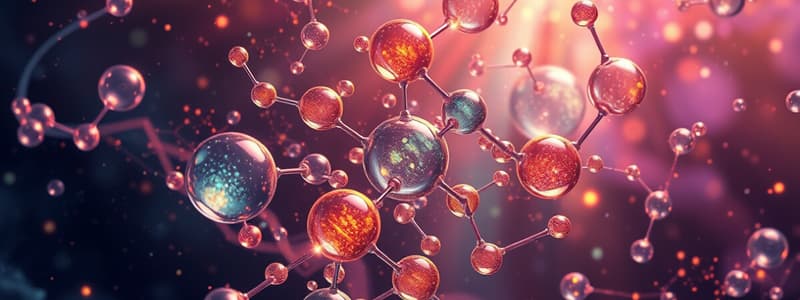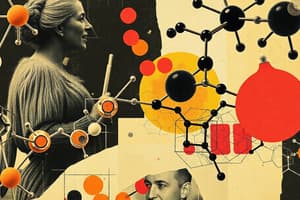Podcast
Questions and Answers
Which group of elements includes sodium and potassium, essential for maintaining osmotic equilibrium?
Which group of elements includes sodium and potassium, essential for maintaining osmotic equilibrium?
- Transition metals
- Group 2A elements
- Group 1A elements (correct)
- Noble gases
What role does ionized calcium (Ca2+) NOT regulate?
What role does ionized calcium (Ca2+) NOT regulate?
- Muscle contraction
- Blood clotting
- Hormone action
- Osmotic pressure (correct)
Which non-covalent interaction involves attractions between non-polar molecules?
Which non-covalent interaction involves attractions between non-polar molecules?
- Van der Waals interactions (correct)
- Ionic interactions
- Hydrogen bonds
- Dipole-dipole interactions
What is the main application of lithium in medicine?
What is the main application of lithium in medicine?
Which of the following statements regarding free radicals is true?
Which of the following statements regarding free radicals is true?
What is a primary biological role of sulfur?
What is a primary biological role of sulfur?
Which of the following elements is essential for the conversion of thyroxine to triiodothyronine?
Which of the following elements is essential for the conversion of thyroxine to triiodothyronine?
Which trace element is critical for the function of cytochrome c oxidase?
Which trace element is critical for the function of cytochrome c oxidase?
What is the primary role of cobalt in biological systems?
What is the primary role of cobalt in biological systems?
Which of the following is NOT considered a transition element of biological importance?
Which of the following is NOT considered a transition element of biological importance?
What role does magnesium primarily serve in the body?
What role does magnesium primarily serve in the body?
Which element is known to act in synergy with vitamin D for bone health?
Which element is known to act in synergy with vitamin D for bone health?
What is a significant function of nitrogen in biological systems?
What is a significant function of nitrogen in biological systems?
Which element is primarily known for being a major constituent of organic compounds?
Which element is primarily known for being a major constituent of organic compounds?
What role does oxygen play in the human body?
What role does oxygen play in the human body?
Silicon is important primarily because it is a constituent of which tissue?
Silicon is important primarily because it is a constituent of which tissue?
Which ionized form of magnesium is specified as a cofactor in enzyme function?
Which ionized form of magnesium is specified as a cofactor in enzyme function?
Phosphorus plays a vital role in what part of human anatomy?
Phosphorus plays a vital role in what part of human anatomy?
What is a primary characteristic of Sodium (Na+) in the human body?
What is a primary characteristic of Sodium (Na+) in the human body?
Calcium primarily exists inside the cells in ionized form Ca2+.
Calcium primarily exists inside the cells in ionized form Ca2+.
What role do free radicals and reactive oxygen species play in biological systems?
What role do free radicals and reactive oxygen species play in biological systems?
Lithium is known to treat __________ in bipolar disorder.
Lithium is known to treat __________ in bipolar disorder.
Match the following biologically important elements with their primary functions:
Match the following biologically important elements with their primary functions:
What is the primary function of selenium in biological systems?
What is the primary function of selenium in biological systems?
Copper is not associated with any enzymes in biological systems.
Copper is not associated with any enzymes in biological systems.
Name one transition element that is a component of vitamin B12.
Name one transition element that is a component of vitamin B12.
Chlorine plays a critical role in maintaining _______ and electrolyte balance.
Chlorine plays a critical role in maintaining _______ and electrolyte balance.
Match the following trace elements with their primary function:
Match the following trace elements with their primary function:
What is a primary role of magnesium in the body?
What is a primary role of magnesium in the body?
Silicon is primarily associated with the health of bones and teeth.
Silicon is primarily associated with the health of bones and teeth.
Which Group 5A element is a signaling molecule with various effects on the body?
Which Group 5A element is a signaling molecule with various effects on the body?
Oxygen is the most abundant element in the human body and is a constituent of ______.
Oxygen is the most abundant element in the human body and is a constituent of ______.
Match the following Group elements with their primary roles:
Match the following Group elements with their primary roles:
Which role is associated with phosphorus in the human body?
Which role is associated with phosphorus in the human body?
Ionized magnesium (Mg2+) plays a significant role in muscle contraction.
Ionized magnesium (Mg2+) plays a significant role in muscle contraction.
What is the primary biological role of oxygen in the human body?
What is the primary biological role of oxygen in the human body?
Flashcards are hidden until you start studying
Study Notes
Biologically Important Elements
- Hydrogen: Major component of water and biomolecules, essential for basic life functions.
- Sodium & Potassium: Key for osmotic balance, nerve transmission, and maintaining cellular function; asymmetric distribution critical for nerve impulses.
- Lithium: Used in bipolar disorder treatment; promotes uric acid dissolution and may support longevity.
Alkali Earth Metals
- Calcium: Vital for bone structure, blood clotting, and enzyme activities; regulates neuromuscular excitability.
- Magnesium: Important for energy production, enzyme function, and muscle contraction; structural component of DNA.
Group 3A and 4A Elements
- Boron: Supports calcium and phosphorus metabolism; interacts synergistically with vitamin D for bone health.
- Carbon: Found in all biomolecules (proteins, fats, nucleic acids); maintains blood pH and is key in energy processes.
- Silicon: Integral for connective tissues and proteoglycans in cartilage.
Group 5A Elements
- Nitrogen: Essential for amino acids, proteins, and nucleic acids; nitric oxide serves as a signaling molecule.
- Phosphorus: Forms part of bone structure and key biomass molecules, crucial in energy transfer and pH regulation.
Group 6A Elements
- Oxygen: Most abundant element in the body, crucial for respiration; produces reactive oxygen species involved in various diseases.
- Sulfur: Significant for protein structure, vitamins, and antioxidant functions.
- Selenium: Component of protective enzymes against free radicals, and involved in thyroid hormone conversion.
Group 7A Elements
- Chlorine: Anion in biological fluids, essential for osmotic balance and fluid regulation.
- Fluorine: Strengthens bones and teeth; wards off dental issues.
- Iodine: Critical for thyroid hormone production, affecting metabolism and growth.
Transition Elements
- Copper: Required for multiple enzymes including those in metabolic pathways and antioxidant defense.
- Zinc: Integral to insulin structure and various enzymes, functioning in immune response and metabolic processes.
- Chromium: Enhances insulin action for glucose metabolism.
- Iron: Fundamental for oxygen transport in hemoglobin; key in enzymatic reactions.
- Cobalt: Vital for producing vitamin B12; plays a role in red blood cell formation.
Non-Covalent Interactions
- Ionic Interactions: Result from electrostatic attractions between charged ions, establishing ionic bonds.
- Van der Waals Interactions: Weak attractions between molecules, significant in maintaining molecular structure.
- Hydrogen Bonds: Stronger than Van der Waals forces, essential for the secondary and tertiary structures of proteins.
- Hydrophobic Interactions: Non-polar interactions drive molecules to exclude water, influencing protein folding and membrane structure.
Biologically Important Elements
- Hydrogen: Major component of water and biomolecules, essential for basic life functions.
- Sodium & Potassium: Key for osmotic balance, nerve transmission, and maintaining cellular function; asymmetric distribution critical for nerve impulses.
- Lithium: Used in bipolar disorder treatment; promotes uric acid dissolution and may support longevity.
Alkali Earth Metals
- Calcium: Vital for bone structure, blood clotting, and enzyme activities; regulates neuromuscular excitability.
- Magnesium: Important for energy production, enzyme function, and muscle contraction; structural component of DNA.
Group 3A and 4A Elements
- Boron: Supports calcium and phosphorus metabolism; interacts synergistically with vitamin D for bone health.
- Carbon: Found in all biomolecules (proteins, fats, nucleic acids); maintains blood pH and is key in energy processes.
- Silicon: Integral for connective tissues and proteoglycans in cartilage.
Group 5A Elements
- Nitrogen: Essential for amino acids, proteins, and nucleic acids; nitric oxide serves as a signaling molecule.
- Phosphorus: Forms part of bone structure and key biomass molecules, crucial in energy transfer and pH regulation.
Group 6A Elements
- Oxygen: Most abundant element in the body, crucial for respiration; produces reactive oxygen species involved in various diseases.
- Sulfur: Significant for protein structure, vitamins, and antioxidant functions.
- Selenium: Component of protective enzymes against free radicals, and involved in thyroid hormone conversion.
Group 7A Elements
- Chlorine: Anion in biological fluids, essential for osmotic balance and fluid regulation.
- Fluorine: Strengthens bones and teeth; wards off dental issues.
- Iodine: Critical for thyroid hormone production, affecting metabolism and growth.
Transition Elements
- Copper: Required for multiple enzymes including those in metabolic pathways and antioxidant defense.
- Zinc: Integral to insulin structure and various enzymes, functioning in immune response and metabolic processes.
- Chromium: Enhances insulin action for glucose metabolism.
- Iron: Fundamental for oxygen transport in hemoglobin; key in enzymatic reactions.
- Cobalt: Vital for producing vitamin B12; plays a role in red blood cell formation.
Non-Covalent Interactions
- Ionic Interactions: Result from electrostatic attractions between charged ions, establishing ionic bonds.
- Van der Waals Interactions: Weak attractions between molecules, significant in maintaining molecular structure.
- Hydrogen Bonds: Stronger than Van der Waals forces, essential for the secondary and tertiary structures of proteins.
- Hydrophobic Interactions: Non-polar interactions drive molecules to exclude water, influencing protein folding and membrane structure.
Studying That Suits You
Use AI to generate personalized quizzes and flashcards to suit your learning preferences.



